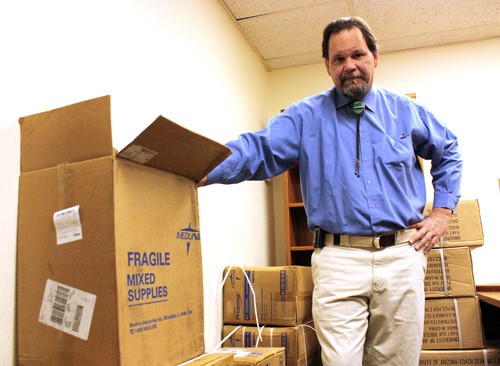For the past five years, University Medical Center orthopedic surgeon Dr. Joseph Sheppard has provided humanitarian aid in the form of medical care to developing nations.
He’s traveled to Honduras as part of a group called Orthopedics Overseas, and had planned to travel to Nicaragua this year.
So when Sheppard first heard reports of the 7.0-magnitude earthquake that struck Haiti on Jan. 12, he knew he had to help.
“”It was something that I just wanted to do,”” said Sheppard, who has been an orthopedic surgeon for 25 years. “”I knew that I had skills that were potentially helpful to individuals that didn’t have access to them.””
Sheppard had no contacts in Haiti, so he first contacted the American Academy of Orthopedic Surgeons about getting on a list of volunteers. He then joined various organizations in an attempt to get on their lists for the first wave of surgeons.
“”By the very nature of the disaster, I knew the majority of medical problems were going to be orthopedic,”” he said. “”Broken bones, orthopedics involves muscular and skeletal system, arms, legs, pelvis-crushed injuries.””
Sheppard read a newspaper article about an orthopedic surgeon in Phoenix who was going on a mission in Saint-Louis du Nord, located north of Haiti’s capital, Port-au-Prince, on the coast. Two weeks after the earthquake, Sheppard was in Haiti.
“”Despite my efforts to get there as soon as I could, there wasn’t an opportunity for me to go until I made contact with this mission,”” he said.
Sheppard said the mission was located far from the epicenter of the earthquake, and there were no visible signs of damage. The mission consisted of two operating rooms and was powered by a generator.
“”The facilities were clean and sterile,”” he said. “”Everyone brings their own supplies. It was very well stocked. Given the spectrum that everything that was done there, we weren’t in a tent.””
Unlike some doctors who volunteered in Haiti, Sheppard’s mission was clean and modern.
“”From some of the other reports that I have read from other surgeons was that the conditions weren’t quite satisfactory, but you take what you can,”” Sheppard said. “”Everything was immediate in Port-au-Prince so the first response was to create a MASH unit. The University of Miami orthopedics were heavily involved in that. They had the equipment and they had the personnel to set up a tent and an operating room.””
During the 10 days Sheppard was there, he treated numerous broken bones, including a spinal fracture and infections that were present, but not related to the earthquake.
In one case, he treated a young woman who had her wrist crushed. Tissue had been torn off the side of her wrist and hand, exposing bone and nerves.
In order to treat the woman, Sheppard did what was called a rotational flap, which is where a surgeon rotates the skin from the forearm to cover the bone and nerves, and then adds skin grafts.
“”It’s not possible to do a skin graft on top of a nerve or on top of a bone, so you have to bring in tissue that is full thickness and has its own blood supply,”” he said.
Because of the 10-day limitation Sheppard faced, he had to consider alternative options for the woman. Under normal circumstance, the surgery would require three to four weeks..
“”So we had to do something a little more risky, but so far so good,”” he said.
Sheppard returned to Tucson Feb. 6 and expects to return to Haiti later this year.









